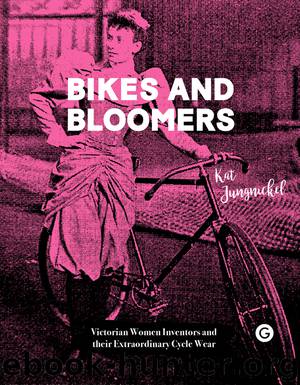Bikes and Bloomers by Jungnickel Kat;

Author:Jungnickel, Kat;
Language: eng
Format: epub
Publisher: Goldsmiths, University London
Madame Julia Gill’s court dressmaking services were probably one of many small businesses offering services to new cyclists, amongst other seasonal dress requirements. Through her patented design, we might assume her politics were not far from those of dress reformers, in terms of supporting and enabling women to move more freely in public space. However, she was also a businesswoman, so probably had a keen eye for new ideas. Julia may have been commissioned to make something similar for a client and identified the potential for patenting it. Alternatively, she may have taken the opportunity to pre-empt the pre-Season rush with her own design as a means of attracting a new clientele.
Julia timed her patent well, not only during the slow time of year but also at the start of 1895, which heralded the cycling boom. This was a tactic of other London-based court dressmakers. Madame Evelina Susannah Furber (1858–1945) was also a court dressmaker in the 1890s. She had a shop at 118B Cromwell Road, West Kensington, in London and like Julia she designed a convertible cycling garment for women. She was particularly entrepreneurial. She did not wait to have the patent commericalised by someone else. She did it herself. She produced the garment and promoted it with adverts and editorial in popular cycling and women’s magazines. The skirt alone was sold for two and a half guineas or could be purchased complete with a coat or jacket to match for four and a half guineas. This was much more expensive than the ‘Bygrave Convertible Skirt’. The price difference is understandable considering the economies of scale that the larger corporation would have been operating within and also because Evelina was offering a tailor-made costume.
The ‘Furber Bicycle Skirt’ was promoted in The Lady Cyclist as a ‘charming’ and ‘novel’ skirt with concealed fastenings that created ‘a perfect divided skirt if required’.17 The Queen called it ‘a most practical invention’ because it ‘cannot blow up’ and assured potential buyers that they would ‘have a handsome walking gown as well as a graceful and becoming bicycle dress’.18 Essentially the ‘Furber’ was a divided skirt, featuring a seam at the front and back which, when unbuttoned and re-buttoned to an under layer, forms two legs. Evelina explains in her patent how ‘[e]ach edge of the back opening can also be connected to the same side of the front opening so transforming the skirt into a pair of loose trousers’.19 A strap, released from the back waistband, passed through the fork to attach at the front and apparently kept these divided legs in place.
The Furber was one of nine new garments from independent dressmakers and tailors showcased in The Queen’s 1896 full-page special: ‘The New Cycling Costumes of the Season’. This type of editorial reveals the breadth of styles available and the fierce competition of independent businesses vying for reader’s attention and buyer’s purses. The illustration of Evelina’s design shows a woman astride a bicycle, and the pose reveals the subtlety of the transformation.20
Download
This site does not store any files on its server. We only index and link to content provided by other sites. Please contact the content providers to delete copyright contents if any and email us, we'll remove relevant links or contents immediately.
On Writing A Memoir of the Craft by Stephen King(4863)
The Doodle Revolution by Sunni Brown(4685)
A Simplified Life by Emily Ley(4097)
Mummy Knew by Lisa James(3630)
Marijuana Grower's Handbook by Ed Rosenthal(3619)
Better Homes and Gardens New Cookbook by Better Homes & Gardens(3524)
Figure Drawing for Artists by Steve Huston(3380)
Paper Parties by Erin Hung(3369)
Draw Your Day by Samantha Dion Baker(3286)
The Genius of Japanese Carpentry by Azby Brown(3223)
Japanese Design by Patricia J. Graham(3108)
The Code Book by Simon Singh(3074)
Dangerous Girls by Haas Abigail(2976)
Lions and Lace by Meagan Mckinney(2922)
The Curated Closet by Anuschka Rees(2912)
How to Make Your Own Soap by Sally Hornsey(2826)
The Checklist Manifesto by Atul Gawande(2776)
The Wardrobe Wakeup by Lois Joy Johnson(2731)
Zero to Make by David Lang(2726)
